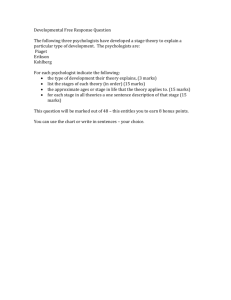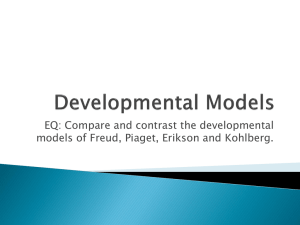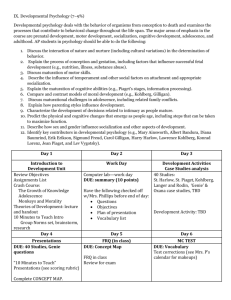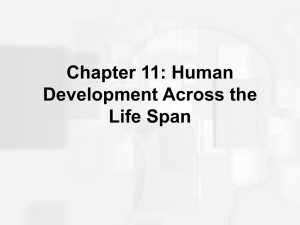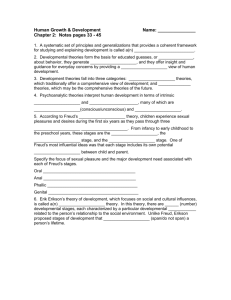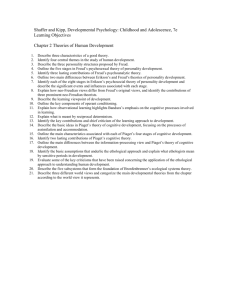Educational Psychology: Theories of Development
advertisement
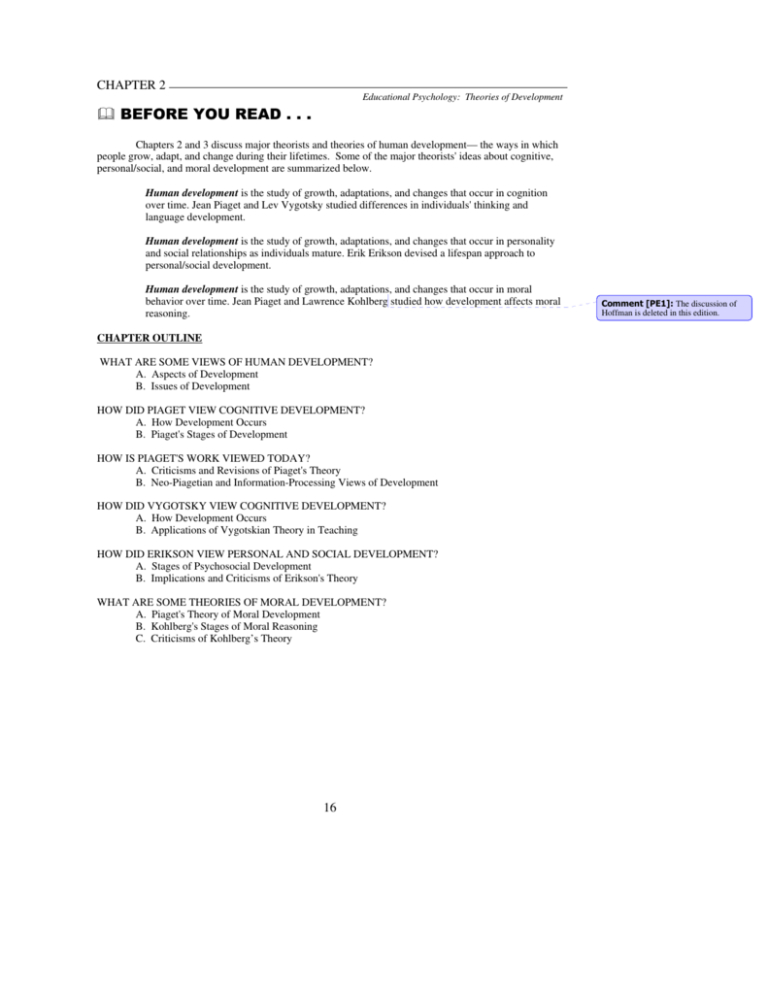
CHAPTER 2 Educational Psychology: Theories of Development BEFORE YOU READ . . . Chapters 2 and 3 discuss major theorists and theories of human development— the ways in which people grow, adapt, and change during their lifetimes. Some of the major theorists' ideas about cognitive, personal/social, and moral development are summarized below. Human development is the study of growth, adaptations, and changes that occur in cognition over time. Jean Piaget and Lev Vygotsky studied differences in individuals' thinking and language development. Human development is the study of growth, adaptations, and changes that occur in personality and social relationships as individuals mature. Erik Erikson devised a lifespan approach to personal/social development. Human development is the study of growth, adaptations, and changes that occur in moral behavior over time. Jean Piaget and Lawrence Kohlberg studied how development affects moral reasoning. CHAPTER OUTLINE WHAT ARE SOME VIEWS OF HUMAN DEVELOPMENT? A. Aspects of Development B. Issues of Development HOW DID PIAGET VIEW COGNITIVE DEVELOPMENT? A. How Development Occurs B. Piaget's Stages of Development HOW IS PIAGET'S WORK VIEWED TODAY? A. Criticisms and Revisions of Piaget's Theory B. Neo-Piagetian and Information-Processing Views of Development HOW DID VYGOTSKY VIEW COGNITIVE DEVELOPMENT? A. How Development Occurs B. Applications of Vygotskian Theory in Teaching HOW DID ERIKSON VIEW PERSONAL AND SOCIAL DEVELOPMENT? A. Stages of Psychosocial Development B. Implications and Criticisms of Erikson's Theory WHAT ARE SOME THEORIES OF MORAL DEVELOPMENT? A. Piaget's Theory of Moral Development B. Kohlberg's Stages of Moral Reasoning C. Criticisms of Kohlberg’s Theory 16 Comment [PE1]: The discussion of Hoffman is deleted in this edition. CHAPTER 2 Educational Psychology: Theories of Development AS YOU READ . . . WHAT ARE SOME VIEWS OF HUMAN DEVELOPMENT? 1. In the following chart, identify the theory that each theorist proposed and the type of development involved. You will complete this chart as you read the chapter, so do not worry about the other items right now. PIAGET VYGOTSKY THEORY TYPE OF DEVELOPMENT CENTRAL CONCEPTS NATURE OF LEARNING LEARNING CONTEXT MORAL DEVELOPMENT STAGES (include approximate ages) 17 ERIKSON KOHLBERG CHAPTER 2 Educational Psychology: Theories of Development HOW DID PIAGET VIEW COGNITIVE DEVELOPMENT? 2. Fill in the following chart of Piaget’s phenomena with original examples from your own experience or observation. Piaget’s Term scheme Example Organizing your understanding of trees into coniferous and deciduous. assimilation A child I know believed the Earth is flat because the horizon is flat. When told that the Earth is round, she thought, “round and flat, like a disk.” accommodation My niece just learned that hymns are not "boys' songs" (hims). equilibration Trying to remember someone's name when I can't (disequilibration), then suddenly remembering it (equilibration). Your Example 3. Enter Piaget’s four stages of development in the Central Concepts row on the comparison chart you started in exercise number 1. 18 CHAPTER 2 Educational Psychology: Theories of Development 4. Write the following tasks in the chart under the correct Piaget stage: a) inferred reality, b) reflexes, c) abstract thinking, d) object permanence, egocentrism, e) use of symbols, f) centration, g) use of logic, h) reversibility, i) goal direction, j) conservation, k) perceived appearances, l) reciprocity, m) inversion, and n) class inclusion. Give an original example of each task. PIAGET STAGE sensorimotor TASKS EXAMPLES looking for a toy when it is out of sight placing your finger in the palm of an infant's hand and the infant grasping it using words to represent thought ("Mama") pulling on a blanket holding a toy that is out of reach preoperational considering height but not width when solving a problem that involves both; thinking the sun sets (goes down below the earth) thinking that farmers have cows so you can look at them concrete knowing the illusion of the sun setting is operational, caused by the rotation of the earth knowing that 7 + 5 = 12 can be reversed to show that 12 - 5 = 7 knowing that 1/2 is different from 2/1; arranging dinosaurs into meat eaters and plant eaters knowing that the volume of a liquid poured from one container to another remains constant formal reasoning through an analytic problem thinking what it would have been like had Germany won World War I 19 YOUR EXAMPLE CHAPTER 2 Educational Psychology: Theories of Development HOW IS PIAGET'S WORK VIEWED TODAY? 5. List four general teaching implications of Piagetian principles. 6. Describe a teaching strategy that applies Piagetian concepts in the classroom. 7. Summarize the arguments against Piaget’s theory of cognitive development. HOW DID VYGOTSKY VIEW COGNITIVE DEVELOPMENT? 8. On the comparison chart of theorists in exercise number 1, enter the views of Piaget and Vygotsky on the nature of learning and the context in which learning takes place. Then, below, describe a teaching strategy that applies Vygotskian concepts in the classroom. HOW DID ERIKSON VIEW PERSONAL AND SOCIAL DEVELOPMENT? 9. On the comparison chart of theorists in exercise number 1, fill in Erikson's eight stages of psychosocial development. Label which of Erikson's stages pertains respectively to preschool, elementary school, middle school, and secondary school student. Below, compare Erikson’s eight stages to Piaget’s four stages of cognitive development. 10. In the space below, give an example in which a person experiences and then successfully resolves each psychosocial crisis that occurs before and during the school years. In each instance, give an example of how a parent or teacher might help an individual resolve the development crisis in a positive way. Finally, complete the boxes in the chart of theorists with Erickson’s stages that correspond to Piaget’s stages. 20 CHAPTER 2 Educational Psychology: Theories of Development WHAT ARE SOME THEORIES OF MORAL DEVELOPMENT? 11. On the comparison chart, fill in Kohlberg's six stages of moral reasoning. Label each level of thinking with the appropriate age. Compare Kohlberg’s stages to Piaget's two stages of moral development. 12. Give an original example of a moral dilemma, and explain how different individuals' judgments can illustrate each of Kohlberg's levels. Moral Dilemma Description: Kohlberg’s Level of Moral Development Judgment Example 21 CHAPTER 2 Educational Psychology: Theories of Development SELF-CHECK DIRECTIONS: The following questions are related to the main ideas of the chapter. The answers are provided at the end of the study guide chapter. 1. Which of the following pairs of issues are central to developmental psychology? A. assimilation and accommodation B. nature vs. nurture and continuous vs. discontinuous development C. preconventional thinking and postconventional thinking D. zone of proximal development vs. private speech and scaffolding 2. Match each of the following stages of cognitive development with its definition. ______ sensorimotor preoperational concrete operational A. Exploration of the environment occurs mostly through the use of the five senses and motor skills. B. Learners are capable of hypothetical, abstract thought and scientific reasoning. formal operational C. Learners make errors when attempting to solve conservation tasks because they center on one aspect of the problem. D. Inferable reality, seriation, and transitivity are cognitive skills possessed by these learners. 3. Write a brief paragraph explaining the difference between assimilation and accommodation. 4. Piaget’s principles have been criticized because recent research demonstrates that A. many children go through cognitive stages in varying orders. B. cognitive tasks such as conservation cannot be taught unless the child is in the appropriate stage. C. the clarity of task instruction can significantly influence young children’s performance on conservation tasks. D. children, on the average, are actually less competent than Piaget thought. 5. Vygotsky suggested that when students are capable of learning but have not yet learned, teachers should assist them by using any of the following methods, except A. B. C. D. social interaction and private speech. assisted discovery and problem solving. perceived appearances. scaffolding. 22 CHAPTER 2 Educational Psychology: Theories of Development 6. A typical individual who is in Piaget’s stage of concrete operations is, at the same time, in Erikson’s stage of A. B. C. D. autonomy vs. doubt. industry vs. inferiority. intimacy vs. isolation. generativity vs. self-absorption. 7. The psychosocial stage associated with adolescence is A. B. C. D. identity vs. role confusion. industry vs. inferiority. intimacy vs. isolation. integrity vs. despair. 8. Match each level of Kohlberg’s theory of moral development with its definition. preconventional A. Self-chosen, ethical principles guide moral decision making. conventional B. The self is of the greatest concern. postconventional C. Moral decisions are made to satisfy the needs of the group and to maintain the social order. 9. In the space below, describe typical preoperational, concrete operational, and formal operational learners (i.e., they are developing as the theorists proposed); then add statements about their psychosocial and moral development. 23 CHAPTER 2 Educational Psychology: Theories of Development AFTER YOU READ . . . PRACTICE TEST DIRECTIONS: Each major section of the chapter is listed below with a series of related questions worth a total of ten points. Respond to each question, check your answers against those at the end of the study guide chapter, then determine your score. If you get nine points per heading, you have mastered the content. WHAT ARE SOME VIEWS OF HUMAN DEVELOPMENT? 1. (1 point) True or False Development refers to the changes in physical, personal, social, cognitive, and moral characteristics that occur over one’s lifespan. 2. (1 point) Children are like miniature adults; their thinking is qualitatively the same as adults' thinking. 3. (1 point) One of the first requirements of effective teaching is that the teacher understand how students think and view the world. 4. (3 points) Matching major developmental theorist who studied cognition A. Erikson B. Kohlberg major developmental theorist who studied moral reasoning C. Piaget major developmental theorist who studied personal growth and social relationships 5. (2 points) 6. (2 points) Short Answer/Essay Describe the nature vs. nurture controversy. Define and give an example of a discontinuous theory of development. Define and give an example of a continuous theory of development. 24 CHAPTER 2 Educational Psychology: Theories of Development HOW DID PIAGET VIEW COGNITIVE DEVELOPMENT? 7. (1 point) Sentence Completion are mental patterns that guide thinking and behavior. 8. (1 point) is the process of incorporating new information into existing schemes. 9. (1 point) is the process of modifying existing schemes so that new knowledge can be understood. 10. (4 points) Matching Inferred reality— the ability to see things in context—is a characteristic of an individual who is at this stage. Hypothetical—the ability to deal with possibilities—is a characteristic of an individual who is at this stage. A. sensorimotor B. preoperations C. concrete operations D. formal operations Object permanence—knowing that an object exists when it is out of sight—is a characteristic of an individual who is at the end of this stage. Egocentric behavior—believing that everyone shares one’s beliefs—is a characteristic of an individual who is at this stage. 11. (1 point) Multiple Choice Which of the following is an example of conservation? A. A student is able to explain why the amount of water poured from a short, wide beaker into a tall, narrow beaker remains constant. B. A student can select one choice from a variety of alternatives in order to form a hypothesis. C. A student who used to call all small animals "kitty" can now discriminate between a cat and a skunk. D. A student can place 10 sticks of various lengths in order from shortest to tallest. 25 CHAPTER 2 Educational Psychology: Theories of Development 12. (1 point) At the end of Piaget's concrete operational stage, a child is capable of all of the following tasks except A. B. C. D. 13. (1 point) class inclusion. transitivity. decentration. testing hypotheses. The abilities that make up formal operational thought are critical to learning which of the following cognitive tasks? A. B. C. D. conservation higher-order thinking skills assimilation and accommodation equilibration HOW IS PIAGET'S WORK VIEWED TODAY? 14. (1 point) True or False Piaget believed that developmental stages are fixed—that certain cognitive tasks cannot be completed until the individual is developmentally ready. 15. (1 point) Recent research demonstrates that children are more competent than Piaget originally thought. 16. (1 point) Neo-Piagetians have found that Piaget's beliefs about children's egocentrism—seeing only their own point of view—remain accurate, even when familiar tasks and age appropriate language are used in testing. 17. (1 point) Multiple Choice Information processing theorists disagree with Piaget on which of the following points? A. B. C. D. 18. (1 point) the description of cognition development precedes learning thinking skills can be directly taught learning is culture- and context-free Neo-Piagetians have demonstrated that learners’ abilities to operate at a particular stage depend on all of the following circumstances except A. B. C. D. the specific task involved. the training received. experience. exposure to computers. 26 CHAPTER 2 Educational Psychology: Theories of Development 19. (1 point) Which of the following approaches represents an information processing view of development? A. B. C. D. 20. (4 points) rule-assessment stage theory self-regulation scaffolding Short Answer/Essay List four criticisms of Piaget’s work. HOW DID VYGOTSKY VIEW COGNITIVE DEVELOPMENT? 21. (1 point) 22. (1 point) 23. (1 point) True or False One important contribution of Vygotsky's theory is that it emphasizes the sociocultural nature of learning. According to Vygotsky, mental functioning exists within the individual before it exists in conservation and collaboration. Sentence Completion is a term used to describe a developmental phase of learning in which a learner will fail at a task if attempted independently but not if she or he is given support. 24. (1 point) is a mechanism for turning shared knowledge into personal knowledge. 25. (1 point) involves providing a learner with support during the early stages of learning and then encouraging him or her to take on greater responsibility as the task becomes more familiar. 26. (1 point) is a teaching approach that emphasizes scaffolding and private speech to solve problems. 27. (4 points) Short Answer/Essay List two major educational implications of Vygotsky's theory, and give an example of each. 27 CHAPTER 2 Educational Psychology: Theories of Development HOW DID ERIKSON VIEW PERSONAL AND SOCIAL DEVELOPMENT? 28. (1 point) True or False Erikson proposed that individuals pass through eight psychosocial stages, with a crisis to be resolved at each stage. 29. (1 point) Most people resolve developmental crises as they pass through the psychosocial stages, but some do not. Thus, they end up dealing with them later in life. 30. (1 point) Erikson's theory de-emphasizes the role of the environment, both in causing a crisis and in determining how it will be resolved. 31 (4 points) Matching stage where “Who am I?’ becomes important A. initiative vs. guilt B. industry vs. inferiority stage where the focus is "I am what I learn" stage of exploring of the physical and social environment C. identity vs. role confusion D. intimacy vs. isolation stage dedicated to finding oneself in another 32. (3 points) Short Answer/Essay List an educational experience that will help develop 1) initiative, 2) industry, and 3) identity. WHAT ARE SOME THEORIES OF MORAL DEVELOPMENT? 33. (1 point) Sentence Completion is a type of moral reasoning in which an individual believes that rules are fixed and unchangeable, according to Piaget. 34. (1 point) is a type of moral reasoning in which an individual considers a transgressor's intentions, according to Piaget. 35. (1 point) is a structured moral situation, developed by Kohlberg. 28 CHAPTER 2 Educational Psychology: Theories of Development 36. (3 points) Matching level of moral reasoning in which individuals obey authority figures to avoid punishment level of moral reasoning in which individuals use ethical principles to guide moral behavior A. preconventional B. conventional C. postconventional level of moral reasoning in which individuals follow social rules 37. (1 point) Multiple Choice Individuals progress from stage to stage by A. B. C. D. 38. (2 points) interacting with those whose moral reasoning is at a higher level. resolving critical and conflicting psychosocial issues. exhibiting socially acceptable behavior. seeking approval and avoiding punishment. Short Answer/Essay List two limitations of Kohlberg's theory of moral development. Now check your answers and total your points. Answers are found at the end of the study guide chapter. SCORING POINTS NEEDED FOR MASTERY WHAT ARE SOME VIEWS OF COGNITIVE DEVELOPMENT? 9 HOW DID PIAGET VIEW COGNITIVE DEVELOPMENT? 9 HOW IS PIAGET'S WORK VIEWED TODAY? 9 HOW DID VYGOTSKY VIEW COGNITIVE DEVELOPMENT? 9 HOW DID ERIKSON VIEW PERSONAL AND SOCIAL DEVELOPMENT? 9 WHAT ARE SOME THEORIES OF MORAL DEVELOPMENT? 9 29 POINTS RECEIVED CHAPTER 2 Educational Psychology: Theories of Development SELF-CHECK ANSWERS Chapter 2 1. B. Two central issues have been debated for decades among developmental psychologists. One relates to the degree to which development is affected by experience (nature vs. nurture) and the other relates to the question of whether development proceeds in stages (continuous vs. discontinuous). 2. A, C, D, B. During the sensorimotor stage (birth to age two), babies and infants explore their world by using their senses and motor skills. Hypothetical and abstract thought are characteristics of formal operational learners. Preoperational children have difficulties when attempting to solve conservation tasks. Inferable reality, seriation, and transitivity are characteristics of the concrete operational learner. 3. Assimilation is the ability to interpret new experiences in relation to existing schemes. When old ways of dealing with the world simply do not work, a learner modifies an existing scheme (accommodation). 4. C. Researchers have found that young children could solve conservation problems when the task was presented in a simple way and with familiar language. 5. C. Studies show that learners who use private speech learn tasks more effectively than do other learners. Vygotsky suggested that teachers encourage learners to use private speech and that teachers use scaffolding, problem solving, and assisted discovery. 6. B. Concrete operational learners are approximately ages seven to 11. Erikson notes that individuals who are six to 12 are in the stage of industry vs. inferiority. 7. A. Erikson viewed adolescence as a time when individuals work on issues of identity. 8. B, C, A. Self-chosen, ethical principles guide the moral behavior of postconventional decision makers. Preconventional individuals are concerned with the self. Conventional individuals are concerned with the wishes and rules of the group. 9. Preoperational children are learning to use symbols to represent the objects in their world; however, their thinking remains egocentric and centered. At the same time, they are working on issues of initiative and base their moral reasoning on avoidance of punishment and on personal gain. Concrete operational learners have developed the ability to decenter, conserve, reverse thought, classify, categorize, and sequence. At the same time, they focus on the demands of acquiring new academic and social competencies and behave in ways that meet the conventions of the group. Formal operational learners think about non-existent possibilities, hypothesize, and reason in logical ways. At the same time, they are working on issues of identity and use conventional moral reasoning. 30 Comment [PE2]: Please capitalize these letters to match the test. CHAPTER 2 Educational Psychology: Theories of Development PRACTICE TEST ANSWERS Chapter 2 1. True; Development refers to the relatively permanent changes that occur over a lifespan. 2. False; Children are not miniature adults. Their thinking is quantitatively and qualitatively different from adult thinking. 3. True; Effective teachers take into account students’ ages and stages of development. 4. C, B, A; Piaget studied cognition; Erikson studied personal growth and social relationships; and Kohlberg studied moral development (as did Piaget; however, Kohlberg is considered the major theorist). 5. Some individuals believe that development is determined at birth by heredity and biological factors (nature), while others believe that development is determined by environmental factors (nurture). Most development psychologists believe that nature and nurture combine to influence development. 6. Discontinuous theories address development as a series of stages, with major tasks to be accomplished at each stage. Piaget, Erikson, and Kohlberg are all discontinuous developmental theorists. Continuous theories address development as a smooth progression from infancy to adulthood. An example of a continuous developmental theory would be information processing. 7. Schemes; Schemes are mental patterns or building blocks used to organize thinking. 8. Assimilation; Assimilation is the process of incorporating new objects or events into existing schemes. 9. Accommodation; Accommodation is the process of changing an existing scheme so that new objects or events can be understood. 10. C, D, A, B; Inferred reality occurs at the concrete operational stage; hypothetical thought is a product of formal operations; object permanence is a sensorimotor stage task; and egocentric behavior occurs during preoperations, according to Piaget. 11. A; Conservation is the ability to understand that even though a variable changes in appearance (as when water is poured from a short, wide beaker into a tall, narrow one), other characteristics (volume) remain constant. 12. D; Hypothesis testing is a characteristic of formal operations. 13. B; The abilities that make up formal operational thought—thinking abstractly, testing hypotheses, and forming concepts independent of physical reality—are critical to learning of higher order thinking skills. 14. True; Piaget held the belief that development precedes learning, that developmental stages are largely fixed, and that certain cognitive tasks require readiness. 15. True; Researchers today have found that children are more competent than Piaget originally thought, especially when their practical knowledge is assessed. 16. False; Researchers have found that children can consider another's point of view if the context is practical and familiar. 31 CHAPTER 2 Educational Psychology: Theories of Development 17. C; Information processing theorists tend to agree with Piaget’s description of cognition; but, unlike Piaget, they believe that thinking skills can be directly taught. 18. D; Neo-Piagetians have demonstrated that an individual’s ability to operate at a particular stage depends a great deal on the specific task involved and that training and experience, including social interactions, can accelerate development. 19. A; Learners acquire increasingly powerful rules or procedures for solving problems and can be stimulated to discover deficiencies in their logic and to apply new logical principles. 20. Criticisms of Piaget’s work include: 1) there may be more than four stages of cognitive development; 2) development of stages is somewhat flexible, not fixed; 3) in practical contexts, preoperational children can consider the views of others; and 4) children are competent learners. 21. True; Vygotsky emphasized the sociocultural nature of learning. 22. False; Vygotsky believed mental functioning exists within conversation and collaboration before it exists within the individual. 23. Zone of Proximal Development; A phase of learning in which the learner will fail alone but succeed with assistance. 24. Private Speech; A mechanism emphasized by Vygotsky for turning shared speech into personal knowledge is private speech. 25. Scaffolding; Scaffolding means providing a learner with support during the early stages of learning and then diminishing that support. 26. Assisted Discovery; This is a scaffolding approach in which teachers explicitly help students use private speech to talk themselves through problems. 27. One implication of Vygotsky's theory is to expose learners to effective problem solving strategies that fall within their zones. An example of this is cooperative learning. A second implication is to incorporate scaffolding into lessons. Reciprocal teaching and assisted discovery are examples of scaffolding. 28. True; Erikson proposed that individuals pass through eight stages, with tasks at each stage. 29. True; When crises are not resolved, they reoccur later. 30. False; Erikson believed the opposite—that the environment played a major role in causing and resolving developmental crises. 31. C, B, A, D; Attending to the question "Who am I?" develops identity. Focusing on "I am what I learn" develops industry. Exploring the physical and social environment develops initiative. Finding oneself in another develops intimacy. 32. Initiative can be developed through exploration of the environment. Industry can be developed by allowing children to try things independently. Identity can be developed by supporting adolescents as they "try on" different adult roles. 32 CHAPTER 2 Educational Psychology: Theories of Development 33. Heteronomous Morality; A type of moral reasoning in which rules are fixed and made by others. 34. Autonomous Morality; This type of moral reasoning incorporates intentions and circumstances into the decision. 35. Moral Dilemma; Kohlberg's structured moral situations are called dilemmas. 36. A, C, B; At the preconventional level, individuals obey rules to avoid punishment. At the conventional level, individuals follow social rules. At the postconventional level, individuals use selfdetermined ethical principles to guide behavior. 37. A; According to Kohlberg, individuals move to higher levels of moral reasoning as they are exposed to them through others. 38. Limitations of Kohlberg's theory include: 1) Kohlberg's research was conducted using males, then generalized to females; and 2) Kohlberg's theory deals with moral reasoning rather than moral behavior. 33

